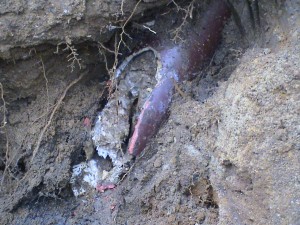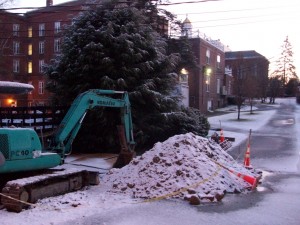November 2011, Vol. 66 No. 11
Features
Pipe Bursting For Replacement Of Sanitary Sewer Laterals
Pipe bursting is a proven method for replacing underground pipelines and is the only method of pipeline rehabilitation and replacement other than open-cut excavation that can increase the size of an existing utility without trenching. This article will discuss the replacement of private sanitary sewer lateral pipes.
Editor’s Note: The International Pipe Bursting Association (IPBA), a division of NASSCO, is presenting a series of articles in Underground Construction that will provide the reader with a better understanding of the technology. Many myths and misconceptions exist regarding this proven rehabilitation method for replacing existing underground utilities.
Pipe bursting is a proven method for replacing underground pipelines and is the only method of pipeline rehabilitation and replacement other than open-cut excavation that can increase the size of an existing utility without trenching. This article will discuss the replacement of private sanitary sewer lateral pipes.
Private residential and commercial sewer laterals often run from the building to the city-owned sewer main with limited access dependent on local building standards. Connection at the building is typically a building cleanout and connection at the main is typically under the city street at a tee or wye. These lateral pipes have been constructed of many different materials over the past 100-plus years including VCP, cast iron, asbestos cement, Orangeburg and PVC. Although each type of existing pipe will have its own failure modes, the need for replacement of these pipelines is a constantly growing market. Complicating the private lateral replacement market is the public versus private line argument in determining where the property owner’s responsibility ends and the municipal responsibility begins. There are a number of scenarios that exist nationally and the approach in your community will need to be established based on local ordinances.

As pipes fail from root growth, joints become offset due to ground movement, corrosion and failure. The need for replacement or rehabilitation is the only option to remove the possibility of backup into private residences or disruption of service for commercial properties. On top of the impact failing sewer lines have on the users, the infiltration of groundwater into the sewer system contributes to overloaded public wastewater treatment facilities adding cost and the potential for overflows into community waterways. Sewer exfiltration will cause sewerage to leave the sanitary sewer line through breaks and failed joints resulting in a potential for contaminating the ground water under private property.
Two primary methods
The two primary methods of addressing private laterals with trenchless methods are CIPP and pipe bursting. These two options both have very distinct advantages and should be considered prior to traditional open-cut construction as the methods can provide long-term service life and meet national and local standards. CIPP is a method of rehabilitation which relines an existing pipe and can often be installed with no digging, whereas pipe bursting is a method of replacement which installs a new pipe with the same or larger inner diameter without the need to open-cut the entire section. However, some excavation will be required.


A pipe that is structurally deficient, partially collapsed, has heavy root growth or severe offsets can be replaced by pipe bursting with little effort needed to prepare or clean the pipe unlike with CIPP lining. A pit or series of pits will need to be excavated to allow access for the newly installed pipe (typically HDPE or PVC) and the pipe bursting machine pit. These pits are strategically placed to limit disruption to the existing property including landscape, hardscape and city easements. The existing pipe is strung with a chain, cable or rod depending on the make and model of pipe bursting machine. It is attached to a pipe bursting head which is approximately 20 percent larger than the outside diameter of the new pipe to be installed and pulled through the existing pipe bursting it while simultaneously pulling in the new pipe. Almost all lateral pipe bursting is done through small tonnage static pipe bursting. However, small diameter pneumatic pipe bursting is possible.
Typical lateral pipe bursting units pull with a static force of 30 to 40-plus tons. These small, portable pipe bursting systems can be run on portable hydraulic excavation units and portable hydraulic power packs. They are easily set-up by hand in small easements and areas that are not easily accessible with excavation equipment, thus limiting the disruption to property.
Most private sewer residential laterals are between 4 – 6-inch inner diameter and commercial private laterals are between four – 8-inch ID. Pipe bursting gives the unique advantage of being able to increase the ID of the pipe allowing additional hydraulic capacity for homes that are looking to add additional facilities or expansions to existing commercial facilities.

It is important to properly identify all public and private utilities in the area including all electrical, water, gas and other pipes that could intersect with the sewer lateral. Following the utility mark-out and one-call system consistent with your community’s guidelines is the minimum requirement for pipe bursting whether on public or private property.
The most common types of pipes installed with lateral or small diameter pipe bursting are HDPE that is fused in a continuous length prior to being installed, and PVC that is installed in sections. HDPE pipe is not a common material for plumbers to work with so there is often some education that needs to be done up-front so there are no surprises in the field.
For a private property owners, pipe bursting is a method that should be considered as a long-term solution to your underground infrastructure replacement. As a utility system owner, it is important to be educated on how pipe bursting works and be able to properly inspect the work performed in your community. As a contractor, pipe bursting is another option you can offer your customers that leaves them with a quality installation, limited disruption and sets you aside from your competitors.
Do your homework, select a quality project team and go pipe bursting! New pipe, more capacity: for pipe bursting the time is now.
Coming in December: Pipe bursting for replacement of large diameter pipeline.
FOR MORE INFORMATION:
IPBA (NASSCO), (410) 486-3500, www.nassco.org




Comments